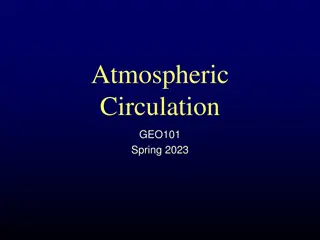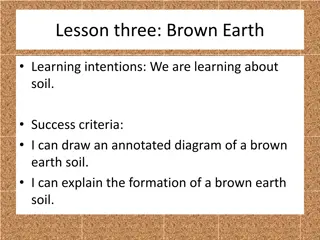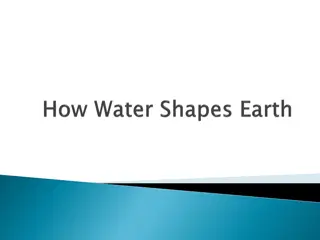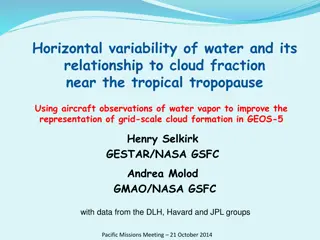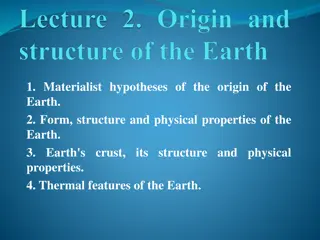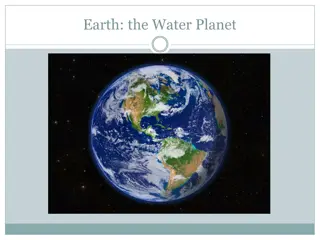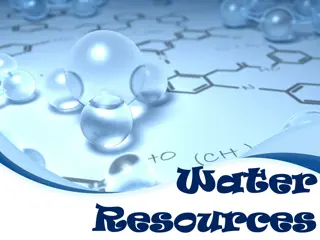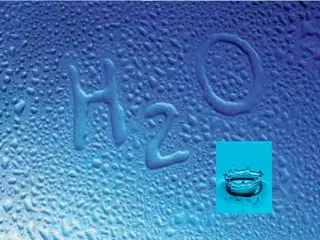The Complicated Formation of Earth's Water: A Detailed Overview
Jun Wu and colleagues at Arizona State University have developed a comprehensive model to explain the origin of Earth's water through stages such as planetary accretion, core formation, and interactions with the solar nebula. By tracing the isotopic composition of hydrogen, they explore how water sources evolved during planetary formation. The model spans from the early stages of planetary embryos containing enough water for several oceans to the processes of magma ocean formation and core-mantle interactions. This study sheds light on the complex journey of Earth's water during its formation.
Download Presentation

Please find below an Image/Link to download the presentation.
The content on the website is provided AS IS for your information and personal use only. It may not be sold, licensed, or shared on other websites without obtaining consent from the author. Download presentation by click this link. If you encounter any issues during the download, it is possible that the publisher has removed the file from their server.
E N D
Presentation Transcript
The Complicated Origin of Earth's Water Jun Wu and colleagues at Arizona State University have examined the issue broadly, considering planetary accretion, magma oceans, core formation, mantle convection, and interaction of a proto-atmosphere with the surrounding solar nebula. Their comprehensive hypothesis uses the isotopic composition of hydrogen as a tracer of the sources of water and its processing during planetary formation and subsequent differentiation. Here is an overview of their model in six stages. http://www.psrd.hawaii.edu/Dec18/origin-earth-water.html
12 Million Years After CAI formation: Planetary embryos in early Solar System 0.1 ME 0.1 ME D/H = 140 x 10-6 (chondritic ratio) 0.4 ME ME = Mass of Final Earth Planetary embryos contain enough water to make 7 to 8 oceans in the final assembled Earth. http://www.psrd.hawaii.edu/Dec18/origin-earth-water.html (Figure based on Wu et al., 2018, JGR:Planets, doi: 10.1029/2018JE005698.) 1
~2 Million Years After CAI formation: Cores form in planetary embryos Mantles: D/H = 150 160 x 10-6 Cores: D/H = 125 135 x 10-6 Mantles are molten (magma oceans) Heating by 26Al causes melting and sinking of metallic iron to form cores in planetary embryos. About 60% of the hydrogen dissolves in cores. Metallic iron takes in hydrogen with lower D/H, resulting in higher D/H in the overlying mantle. http://www.psrd.hawaii.edu/Dec18/origin-earth-water.html (Figure based on Wu et al., 2018, JGR:Planets, doi: 10.1029/2018JE005698.) 2
23 Million Years After CAI formation: Largest embryo forms and retains an atmosphere proto-atmosphere: D/H = 21 x 10-6 H2 magma ocean: D/H = 109 x 10-6 mantle: D/H = 150 160 x 10-6 The proto-atmosphere contains hydrogen from the solar nebula, which has low D/H. It diffuses into the magma ocean, lowering its D/H and providing about 0.14 oceans of H2. This process is called ingassing. http://www.psrd.hawaii.edu/Dec18/origin-earth-water.html (Figure based on Wu et al., 2018, JGR:Planets, doi: 10.1029/2018JE005698.) 3
>3 Million Years After CAI formation: Magma ocean overturn delivers material with low D/H to core-mantle boundary magma ocean: D/H = ~150 x 10-6 Cumulates that interacted with atmosphere: D/H = ~109 x 10-6 (thickness exaggerated) 0.4 ME Highly convecting magma ocean (gray) overturns and mixes materials with low D/H throughout the mantle. However, some low D/H melt or rock sinks to the core-mantle boundary. Earth continues to grow by accretion. http://www.psrd.hawaii.edu/Dec18/origin-earth-water.html (Figure based on Wu et al., 2018, JGR:Planets, doi: 10.1029/2018JE005698.) 4
10100 Million Years After CAI formation: Earth continues to grow through accretion of planetary embryos Earth ends up with ~3 oceans of water in the mantle and an average D/H of 150 x 10-6 Growing Earth The cores of the impacting embryos merge, their mantles mix, their cumulate layers with low D/H get smeared out along the core-mantle boundary. http://www.psrd.hawaii.edu/Dec18/origin-earth-water.html (Figure based on Wu et al., 2018, JGR:Planets, doi: 10.1029/2018JE005698.) 5
Today: Mantle plumes drag up material with low D/H from core-mantle boundary Oceans D/H = 156 x 10-6 1.0 ocean Mantle D/H = 150 x 10-6 Mantle Plume 2.0 oceans Ultra Low Velocity Zone? D/H = 109 x 10-6 Core: D/H = ~130 x 10-6 4.8 oceans http://www.psrd.hawaii.edu/Dec18/origin-earth-water.html (Figure based on Wu et al., 2018, JGR:Planets, doi: 10.1029/2018JE005698.) 6






